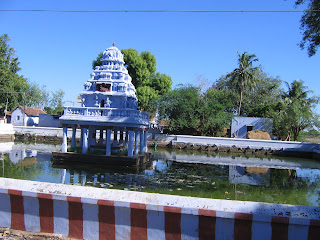Nandi moves to the left to allow
a grand entry for Thiru Gnana Sambandhar
Rama installed Shiva Lingam here
to liberate himself from Chaaya Hathi Dosham after the battle with Ravana
Located
8kms South West of Kumbakonam is the Durgai temple in Patteeswaram that in its
current form was constructed in the 16th Century AD. There are several stories relating to this
huge temple that has 5 towering Gopurams including the 7 tier Rajagopuram. This
is the 23rd Saivite Shrine South of Cauvery as praised in the
Devaram.
The name Patteeswaram
Parasakthi
undertook penance here invoking the blessings of Lord Shiva. Kamadhenu sent her
daughter Patti to support the penance. Pleased with Parasakthi’s prayers, Shiva
appeared here with his long uncombed hair (Sadai Mudi) and provided darshan. As
Patti played an important role in the success of Sakthi’s penance, this place
came to be called Patteeswaram.
Dhenupureeswarar
This is
one of the important places where Kamadhenu, the sacred celestial cow, visited
and undertook penance invoking the blessings of Lord Shiva. Answering her
prayers, Shiva appeared here and promised to fulfil the wishes of devotees who
offer sincere prayers at this temple. In memory of this event, Lord came to be
referred to as Dhenupureeswarar.
Rama’s visit to Patteeswaram
After
defeating Ravana, it is believed that Rama visited Patteeswaram to invoke the
blessings of Lord Shiva to liberate him from Chaaya Hathi Dosham that had
struck him for having killed Vaali striking an arrow from hiding. He installed Shiva Lingam here at
Patteeswaram, one of the three places in Tamil Nadu where he did this, the
other two being Rameswaram and Vedaranyam.
Liberation from curse
Medhavi
Rishi who was undertaking penance in the Maalava kingdom left his ashram to
attend a yagna. He assigned his disciple Dharma Sarma to take care. On return
he found that the cows had become weak significantly impacting their ability to
deliver milk. An angered rishi cursed him to turn into a dog. To liberate himself
from the curse, Dharma Sarma, now in the form of a dog, came here to the South
of Cauvery to Devi Vanam. When the sacred water fell on the dog, he was
liberated from the Sage’s curse and regained his original form.
10day Festival as thanks giving
King
Chitrasena of Kaambeeli had no child. To liberate himself from the sins of the
previous birth, he came here with his wife and undertook bath in the sacred
tank. Pleased with his prayers, Lord Shiva appeared before him in Vaikasi and
blessed him with a child. As a thanks giving to the Lord, a delighted king
started the grand 10day festival in Thai.
Thiru Gnana Sambandhar’s
Patteeswaram trip
The
great Saivite Poet Thiru Gnana Sambandhar, who was on his way to Patteeswaram
to have darshan of Lord Dhenupureeswarar and to sing praise of him, was almost
knocked down by the sweltering heat. To protect him from the heat, Lord Shiva
sent the invisible Devas with a pearl canopy that turned into a beautiful ‘Flower
Top’ much to the surprise of Thiru Gnana Sambandhar.
When he
was about to enter the temple with his disciples, Dhenupureeswarar asked his
Nandi to give way to Thiru Gnana Sambandhar so he could watch the poet’s grand
entry thus providing him darshan right
from the entrance. Hence to this day, the Nandi at the temple is seen slightly
to the left and not directly opposite Dhenupureeswarar.
In
memory of this event, Muthu Pandhal Festival is celebrated at this temple in a
grand way every year in Aani.
Durgai
The
Great Chozha kings including Raja Raja Chozha I had great respect for Durgai and
the Goddess acted as the security guard for them. Also, before their departure
for any battle and also after their return, the Chozha kings would invoke the
blessings of Durgai.
Towards
the end of their regime and with their palace at Patteeswaram going into ruins,
they moved the idol of Durgai into the Northern entrance of the
Dhenupureeswarar temple from where she currently provides darshan to devotees.
At this
temple, Durgai, with Simha Vahana to her left, is seen in a cool form with
eight hands and lacks the typical aggressive looks.
Right
from the Chozha period, Durgai has been so popular as she solves all the
problems of devotees that this temple has come to be referred to as the
Patteeswaram Durgai Temple.
Ancient Landmark
In
centuries gone by, the landmark to this place was denoted as being South of
Arasalaru and North of Mudikondan River.
In the 8th
Century AD, Pallava King Nandivarma II built the beautiful Nandipura Vinnagaram
-Jagannathan Perumal Temple (Divya Desam), a few kms East of Patteeswaram
giving this region a grand stature and a rich place in history. Subsequently, Rajaraja
Chozha, Rajendra Chozha and Kulothunga Chozha made this an integral part of
their kingdom from where they made several
important decisions .
Festivals
10day Festival
in Vaikasi with all the five Utsava deities go out in a procession
Muthupandhal
Festival with a palanquin of pearls
Navarathri
Festival Durga Pooja
Margazhi
Festival – Five Utsavars go out on a procession
How to reach
Patteeswaram
is 8kms South West of Kumbakonam. Auto from Railway station will cost Rs. 150
Town Bus
and mini bus every half hour from Kumbakonam Bus Stand
One can
also board Aavoor bound bus to reach the Patteeswaram temple









